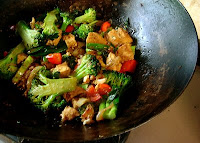Canada’s Thinnest Province Loves its Desserts
 One of the little appreciated facts, is that Quebec happens to have the lowest combined rates of overweight and obesity (56%) of any Canadian province.
One of the little appreciated facts, is that Quebec happens to have the lowest combined rates of overweight and obesity (56%) of any Canadian province.
It now turns out that (as one may have suspected), Quebec is also the one province in Canada that truly maintains a true and distinct eating Culture (that is culture with a capital “C”).
Thus, according to the 15th edition of Eating Patterns in Canada (EPIC), a recent survey from the market research group NPD, Quebecers report eating dessert with supper about 112 times a year compared to about 89 times in Atlantic Canada, 57 in Ontario and 55 on the west coast.
This is also a province that particularly values home-cooked lunch and dinners. Thus, 6 out of 10 lunches and 6.5 out of 10 dinners in Quebec households are apparently made from scratch.
According to the NPD news release,
“Less calorie conscious than the rest of Canada, Quebec households take great pleasure in eating. The majority (82 per cent) also feel that it is important to enjoy full and regular meals each day, which compares to 60 per cent of western Canadians and 63 per cent of Ontarians. As a result, Quebec residents are also the least likely of all the provinces to snack.
Twenty-nine per cent try to avoid snacking entirely and, unlike the rest of the country, have fewer snack occasions annually. Quebecers are also less likely to skip traditional meals (breakfast, lunch and dinner).”
While I am generally cautious about inferring cause-and-effect, I am also the first to support any move to improving eating culture. As I have often said – fast food is more of a ‘fast’ than a ‘food’ problem.
Improving eating culture in the rest of Canada requires a discussion of ‘values’ – apparently, Quebecers place a higher value on home cooking, regular eating, and finding pleasure in food than the rest of us.
Changing this culture will take more than taxing and banning foods. Indeed, I am confident that changing culture will eventually change consumer behaviour, which in turn will ultimately change supply.
No easy task – but perhaps worth a wider discussion. In the mean time, perhaps more of us should enjoy our desserts.
AMS
Edmonton, Alberta
photo credit: Indiewench via photopin cc
Grab the few last remaining tickets for tonight’s Dr. Sharma show online or at the door!
Text Messaging Helps Kids Live Healthy?
 Hard to imagine a few years ago, but a surprising number of kids today have their own mobile phones. One of the most popular use of these phones is text messaging.
Hard to imagine a few years ago, but a surprising number of kids today have their own mobile phones. One of the most popular use of these phones is text messaging.
A new study by Shapiro and colleagues from the University of North Carolina, Chapel Hill, published in J Nutr Educ Behav looks at the use of text messaging for monitoring sugar-sweetened beverages, physical activity, and screen time in children.
Following a brief psychoeducational intervention (1 session weekly for 3 weeks), 58 children (age 5-13) were randomised to SMS with feedback, use of paper diaries (PD) or to a no-monitoring control (C) for 8 weeks. The education sessions aimed to encourage the kids to increase physical activity, decrease “screen time” and reduce consumption of sugar-sweetened beverages. All of the children were given pedometers to track the number of steps they took each day, as well as goals to meet for the number of steps taken, minutes of screen time and number of sugar-sweetened beverages consumed per day.
The text messaging and paper diary groups answered three questions each day: (1) what was the number on your pedometer today?; (2) how many sugar-sweetened beverages did you drink today?; and (3) how many minutes of screen time did you have today?
Unfortunately, only 31 kids (53%) completed the study (SMS: 13/18, PD: 7/18, C: 11/22). Children in SMS had somewhat lower attrition (28%) than both PD (61%) and C (50%), and significantly greater adherence to self-monitoring than PD (43% vs 19%, P < .02).
While the authors conclude that text messaging may be a useful tool for self-monitoring healthful behaviors in children, I remain skeptical.
Indeed, I am yet to be convinced that childhood obesity can be effectively addressed by targeting individual behaviours – a far more promising approach would be to change the overall environment (fewer pizza days, neighbourhoods that are condusive to walking to school and playing outside (less screen time), parents who have time to sit down with their kids for a home-cooked meal, etc.).
Texting kids (or for that matter adults) to promote healthy living strikes me as little more than a gimmick, with minimal long-term impact, if at all.
AMS
Edmonton, Alberta
Trendz in Cafeteria Food
 Yesterday I had lunch at the Cafeteria of the Glenrose Rehabilitation Hospital just across the street from my office at the Royal Alexandra Hospital.
Yesterday I had lunch at the Cafeteria of the Glenrose Rehabilitation Hospital just across the street from my office at the Royal Alexandra Hospital.
The cafeteria is built on Capital Health’s own Healthy Choice Trendz(TM) philosophy that includes a Bistro concept that makes the healthy choice the easy choice. Not only is there no sign of a deep fryer (a rarity for North America) but one really has to look for the unhealthy stuff on the menu.
The standard meat servings are smaller and the plate comes heaped with stir fried vegetables (no oil!) and roast potatoes. Soups come in low-sodium versions, there are even low-fat biscotti, and all breads are whole-grain by default.
Finally, at the coffee outlet, you have a choice of skimmed and 2% milk – cream you have to ask for.
Yes there are some unhealthy choices like pop but the water and juices are up front – the pop you have to actually bend over to pick up.
No problem getting a healthy lunch there – of course, if you try hard, you can find the stuff that it’s better to avoid – but they sure don’t make it easy on you.
Obviously, Capital Health, which developed and is currently establishing the healthy Trendz concept in all of its food outlets, is not only proud of the concept but has assured me that they have even found that offering healthy choices is profitable.
Hopefully the role-out across the region and beyond will not take too long.
AMS
Edmonton, Alberta
p.s the picture is not of the actual food I got, but it certainly comes close
Lifestyle not a Determinant of Obesity in Teens?
 Now here is a counter intuitive finding from Catherine Sabiston, of McGill University, and P.R.E. Crocker, of the University of British Columbia (UBC) published in the Journal of Adolescent Health earlier this year.
Now here is a counter intuitive finding from Catherine Sabiston, of McGill University, and P.R.E. Crocker, of the University of British Columbia (UBC) published in the Journal of Adolescent Health earlier this year.
In their study of 900 Vancouver-area 16-18 year-old teenagers in Grades 10 through 12, neither was there a link between body mass index (BMI) values and levels of physical activity nor did the physically active teens eat a markedly healthier diet than their less-active counterparts.
If anything, the heavier teens were actually the ones making healthier food choices while the teens with “healthier” BMI values were no more likely to be physically active than those with higher, “unhealthier” values.
According to Dr. Sabiston (quoted in a press release from McGill University)
“A lot of people are surprised, but when you think about it, BMI doesn’t have a huge impact on physical activity. And in terms of diet, it actually makes sense that someone who is not happy with their body might try to eat more healthily. What this study really says, is that one cannot assume that someone who is physically active necessarily eats a healthy diet – or the reverse, that someone who is more sedentary or has a high BMI by definition eats a diet of junk food.“
To me the findings aren’t all that surprising. I have always maintained that health cannot be simply deducted from the number on your scale and that for every overweight kid who eats mostly junk food and spends every spare minute on his Xbox, there’s a skinny kid out there who’s no better.
The simple truth is that eating healthy and exercising is important at any weight!
On the other hand, just as simply eating poorly and not exercising by no means guarantees weight gain – simply eating healthy and exercising does not guarantee a so-called “healthy” weight.
When everyone eats too much and no one moves, it’s likely the poor kids with the “wrong” genes that pack on the pounds – the kids with the “right” genes are simply lucky and can apparently get away with their lousy lifestyles – who says life has to be fair!
Of course, the words “wrong” and “right” in the previous sentence refer to these genes in today’s world. Until not all too long ago in the history of mankind, the “wrong” genes would have been just “right” and vice versa (talking of thinking in circles).
AMS
Edmonton, Alberta
[Hat tip to Michael Dwyer of CIHR for sending me the McGill press release]
The Faster the Food – the Greater the Risk?
This weekend, I was invited to participate in a panel discussion following a public viewing of the documentary Super Size Me.
The event was part of the University of Alberta’s Centenary Celebrations and was co-hosted by the Faculty of Medicine and Dentistry’s Arts & Humanities in Health & Medicine program and the Edmonton Public Library in their film series called “Good Medicine”.
As a panelist, I had the opportunity to see the film again and to reflect on what the film is actually about.
Of course, given that the film shows how Morgan Spurlock super sizes himself by eating nothing but McDonald’s for 30 days, this film can easily be interpreted to simply show how bad fast food is for you.
While there is no question that given its high content of fat, sugar and salt, fast food is certainly not the most nutritious food, to me, this is not what the film actually proves.
In fact, when you think about it, Morgan could have splurged on 5000 KCal a day of even the most nutritious and expensive foods for 30 days and probably have gained as much weight and felt as sick in the end. Yes, you can gain weight on healthy foods!
Even the most pricey restaurants, do not necessarily design their meals to be healthy and balanced and I am probably not the only one who has eaten over 2500 KCal in food and wine at a single meal even in restaurants featuring celebrity chefs – no shortage of fat, sugar and salt in those foods either.
So eating at McDonald’s was just a cheaper way to make this film – no doubt, had Morgan eaten all his meals at a 3-star restaurant, he would have needed a much larger budget for his film. In other words – this was just a “cheap” shot at McDonald’s.
Don’t get me wrong – there is nothing healthy about McDonald’s or most of the food you can get at any fast food chain. But the film does not prove this.
What the film does show though, is that eating 5000 KCal a day can lead to weight gain and make you feel pretty sick. What the film also shows is that this is quite easy to do on fast food. Part of this is because the food is so cheap (=affordable). But another important reason why it is so easy to overeat is because the food is designed to be eaten fast.
I have previously blogged about the notion that the problem with fast food is more the “fast” than the “food” (see my post No Time to be Thin). It is indeed very hard to significantly overeat on “slow” food. This is because, when you eat slow, you will be quite full long before you have managed to tuck away 2000 KCal at a single meal. In fact, the bulkier and greater the volume of the food (i.e. the lower the caloric density), the harder it is to eat 2000 KCal at a single meal.
In the film Morgan also criticizes McDonald’s for offering to super size your order (which they have since stopped doing). This, however, is also not so different from what happens in any restaurant, where the servers are trained to offer an appetizer, salad, dessert and more wine if you don’t remember to order these extra calories yourself. They will also be happy to “super size” your steak order by offering to add a lobster tail or extra cream or cheese on you baked potato.
So here is what I think the film does show:
a) eating 5000 KCal a day leads to weight gain, which in turn is likely to make you sick
b) McDonald’s (and no doubt other fast food restaurants) make it easy and affordable for you to do so
c) McDonald’s (and virtually every other restaurant I know of) wants you to eat more and will try any trick in the book to get you to do so
How do we deal with this – for one, we could begin by posting calories on ALL menus – hopefully a disincentive to overeating, no matter how fast or slow the food.
AMS


